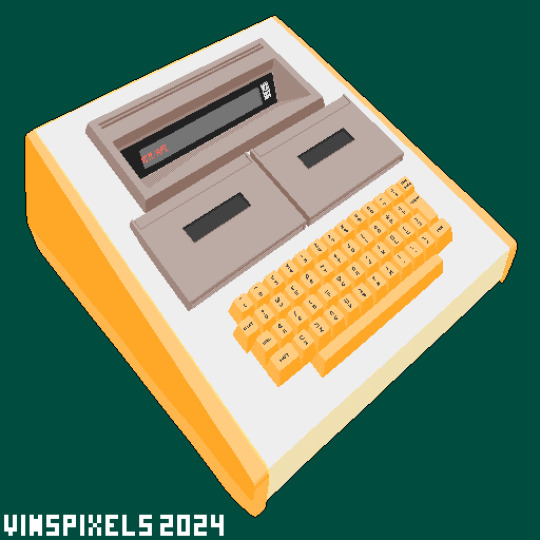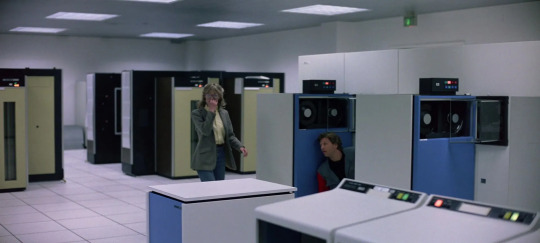#Microcomputers
Photo

For Sci-Fi Dolphin Saturday, here's an uncredited cover to MicroComputer magazine, 1983
3K notes
·
View notes
Text
Vintage TV sticker
#electric appliances#retro appliances#antique appliance#old TVs collection#microcomputers#retro game consoles#retro computer
0 notes
Text

TSR-80 Microcomputer (1982)
#TSR-80 microcomputer#vintage computers#80s christmas#vintage video games#radio shack#vintage gaming#vintage PCs#80s arcade#tandy corporation#1980s#1982
356 notes
·
View notes
Text

MCM/70
A Canadian made Microcomputer from 1974.
144 notes
·
View notes
Text

Una Apple II plus clon de Brasil.
Si, esta Apple no es una Apple original, es clon hecho en Brasil simulando la marca original.
34 notes
·
View notes
Text
Cassette Futurism: The future is saved 200KB at a time.
Domo arigato, Mr. Roboto.
Retrofuturism: This Restless Future | Sleepcore
Tokyo Futures: How Anime Predicted the Future | Retrofuturism and Animation
The underrated aesthetics of cassette Futurism | Jackerman 056
Retro Futurism in film and gaming. A vision of the future, from the past. | Kernatron
The future is saved 200KB at a time.
A place to share and discuss Cassette Futurism: media where the technology closely matches the computers and technology of the late 70s and early 80s.
Whether it's bright colors and geometric shapes, the tendency towards stark plainness, or the the lack of powerful computers and cell phones, Cassette Futurism includes: Cassettes, ROM chips, CRT displays, computers reminiscent of microcomputers like the Commodore 64, freestanding hi-fi systems, small LCD displays, and other analog technologies.
📼🕹️🎛️☢️













#cassette futurism#cassettefuturism#retro scifi#retro futurism#retro aesthetic#retrowave#sci fi#cassette#space#space marines#space ship#blade runner#silent running#cassetes#ROM#ROM chip#crt monitor#microcomputer#commodore#c64#dashboard#car#cars#hi fi stereo#80s aesthetic#kraftwerk#alien#aliens#lcddisplay
28 notes
·
View notes
Text

UK 1987
13 notes
·
View notes
Text
One funny aspect of computer history is that during the 1960s, the term "minicomputer" was introduced for machines that were much smaller than previous computers. Previously, most computers could take up one or several rooms...

But these fancy new "mini" machines were much smaller. Just look at this:

Yep, this was what was considered a "minicomputer", since it was in fact much smaller than "mainframe" computers.
Of course, this seems to have lead to a problem when even smaller computers were introduced during the 70s and 80s, machines that were much closer to our modern desktop computers:

But since the term "minicomputer" was already taken, they decided to call these smaller machines "microcomputers" instead. And apparently some of the even smaller machines we use today (including our modern mobile phones) are sometimes refered to as "nanocomputers".
I honestly think that maybe they should have waited a little longer with using the term "minicomputer", since I think the terminology feels a little "off" considering the scales of the machines that they're currently applied to. But on the other hand, I can understand that people in the 60s might not have been able to imagine having computers that you could carry around in your hand.

Then again...
11 notes
·
View notes
Text

Top 47K - Dragon's Lair + Cruelty Squad
Join the HG101 gang as they discuss and rank the classic laserdisc arcade by Disney’s weirdest animator, and an indie throwback FPS.
#dragon's lair#advanced microcomputer systems#arcade#don bluth#fmv games#cruelty squad#consumer softproducts#microsoft windows#first person shooter#hardcore gaming 101#podcast#top 47858 games of all time#video games#retro games
9 notes
·
View notes
Text

I made a lego case for my Raspberry Pi4 with fan hat and 3.5" LCD touchscreen module (that is attached with a flatwire to the Raspi-fan hat combination).


- - -- --- -----
Yesterday's version of the Raspi case without the screen part:






(the top lid can be opened)
#raspberry pi#hardware#raspi#raspberry pi4#pip boy#hardware setup#minicomputer#microcomputer#lego#custom builds#custom build#custom hardware#diy hardware case#crafty#crafts#craft#tinkering#tinker#diy
10 notes
·
View notes
Text




#scp 079#fanart#felt silly while mzking this#madness and badness. combination🔥#i love this microcomputer with all my heart 🫶
11 notes
·
View notes
Text

#80s aesthetic#80's aesthetic#microblog#microcomputer#personal computer#computer#computers#80's fashion#1980s#1980s fashion#1980s nostalgia#laptop
8 notes
·
View notes
Text

A Datanet advertisement for a specialty microcomputer from the early 2020s
With the cybernetic revolution raging across the world, other digital technologies evolved to support it rather than forming an identity of their own. Given that cybernetics was expected to eventually replace all human-computer interaction, investment into other methods was rare.
By the 2020s, the Datanet existed but primarily for the machine and its programmer. Gigastreams flowed from node to node, carrying terabytes of data between mainframes, robots, and microcomputers. The signals they carried formed the unconscious backbone of society, underground and mostly out of sight.
Between the gigastreams, there existed a space for the human users. The vast majority would be using specialized applications to access electronic conferences, entertainment downloads, interactive encyclopedias, and similar use cases.
The few that ventured further into the machine-facing cyberspace were specialists: cyberneticists, programmers, tinkerers, digital archeologists. It wouldn't be until the first teleindexer — the PAL, from Maple Cybernetic — that the Datanet would be placed into the human palm, fundamentally changing daily life one more time.
#sunsetsystem#retrofuturism#cassette futurism#conceptart#concept art#digital art#artists on tumblr#art#illustration#drawing#sketches#sketch#original art#artwork#procreate#computer#microcomputer
109 notes
·
View notes
Text

North Star HORIZON computer advertisement, featuring a Z80 possessor and 16 whole kilobytes of ram! - Byte magazine July 1978
#byte#vintage computing#vintage computer#retrocomputing#5.25#floppy disk#microcomputer#c64#amiga#ibm#commodore#old tech#byte magazine#vintage advertising#70s#1970s#1978#computer magazine#DOS#s100#kit computer
26 notes
·
View notes
Text

Q1 Microcomputer, 1972
66 notes
·
View notes
Text
youtube
Mi resumen en fotos de la VCF East 2024!!!
#vcf#vintage#computer#east#2024#retro#computers#8 bits#mini computer#microcomputer#commodore#sinclair#apple#Youtube
6 notes
·
View notes